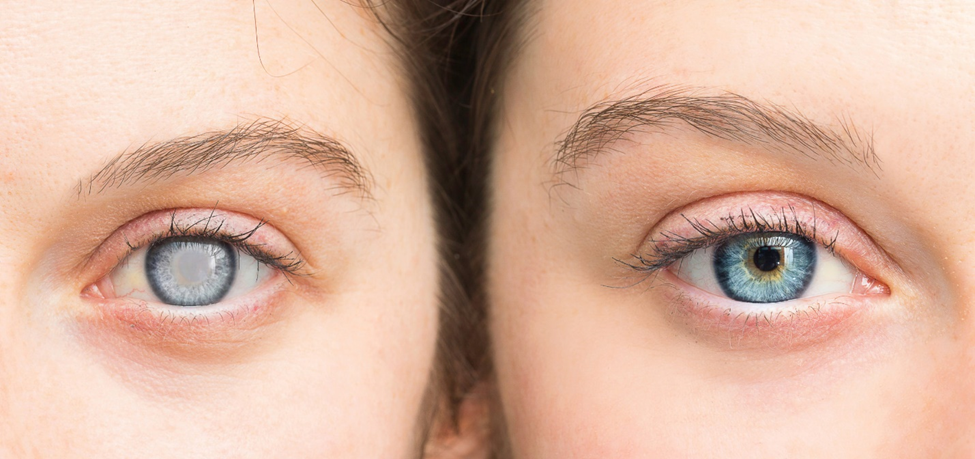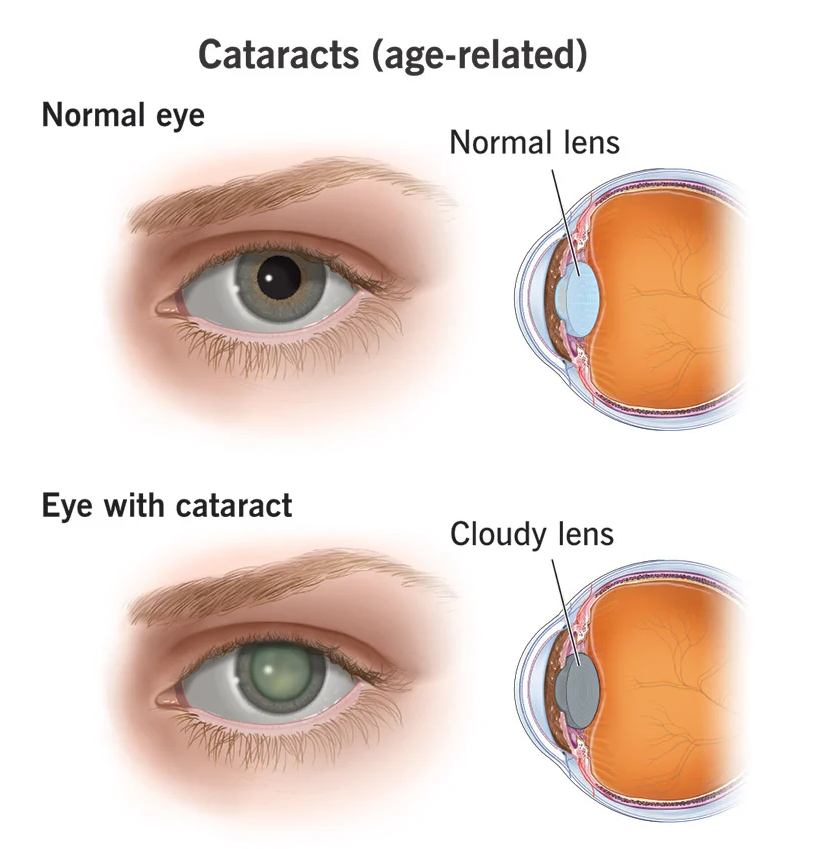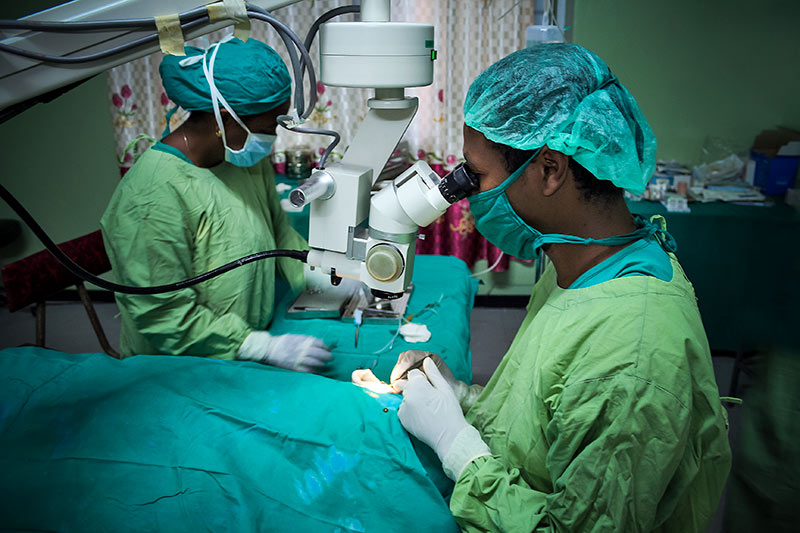CATARACT SURGERY
The purpose of your lens is to bend (refract) light rays that come into the eye to help you see. Your own lens should be clear, but with a cataract it is cloudy. Having a cataract can be like looking through a foggy or dusty car windshield. Things may look blurry, hazy or less colorful. The only way to remove a cataract is with surgery. Your ophthalmologist will recommend removing a cataract when it keeps you from doing things you want or need to do. During cataract surgery, your cloudy natural lens is removed and replaced with a clear artificial lens. That lens is called an intraocular lens (IOL). Your ophthalmologist will talk with you about IOLs and how they work.
Why it’s done
Cataract surgery is done to treat cataracts. Cataracts can cause blurry vision and increase the glare from lights. If a cataract makes it difficult for you to carry out your usual activities, your health care team may suggest cataract surgery.
When a cataract interferes with the treatment of another eye problem, cataract surgery may be recommended. For example, doctors may recommend cataract surgery if a cataract makes it difficult for your eye doctor to examine the back of your eye to monitor or treat other eye problems, such as age-related macular degeneration or diabetic retinopathy.
In most cases, waiting to have cataract surgery won’t harm your eye, so you have time to consider your options. If your vision is still quite good, you may not need cataract surgery for many years, if ever.
When considering cataract surgery, keep these questions in mind:
- Can you see to safely do your job and to drive?
- Do you have problems reading or watching television?
- Is it difficult to cook, shop, do yardwork, climb stairs or take medicines?
- Do vision problems affect your level of independence?
- Do bright lights make it more difficult to see?
Cataract Surgery Cost in Iran
In terms of costs, Iran can be considered among the most affordable countries in which to have such an operation. Not surprisingly, modern hospitals and specialized clinics in various major Iranian cities offer the best care and services to patients from around the world and are considerably affordable as well.
A routine cataract surgery, which in fact is a quite commonplace procedure in Iran, would cost something in the neighborhood of 1500 USD for each eye while the cost of the same operation in most European and American countries would amount to at least 100 percent more. For example, the cost of a cataract surgery in the US is approximately 5,000 USD without insurance. Therefore, as one may perceive, having the treatment done in Iran would be the sensible choice for people the world over. We, at SinoheMedTour, are honored to be the host of cataract surgery patients from various parts of the world. Every year, hundreds of people travel to Iran in search of diverse medical treatments and operations, including eye surgery, and our staff members are glad to assist them through every step of the way from collecting passengers at the airport to arranging their accommodation to providing the information on the intended treatment and the whole process of recovery. With us, you can rest assured that you are in good hands!
If you have read the whole article and still have questions regarding a cataract surgery or a cataract surgery in Iran, you can contact us anytime via our communication channels to get a free online personalized consultation from our medical consultants. This way you can have everything cleared up and make your decision whether to have cataract surgery in Iran with the help of us or think about other options.
Should I Have Cataract Surgery?
Generally, if an individual suffers from blurred vision and has difficulty seeing clearly, they most probably need to have their eyes checked and if confirmed, they had better have the procedure as soon as possible. If a patient has such a condition in both eyes, separate surgeries would be performed several weeks apart on the eyes.
What to Expect Before Cataract Surgery?
The patient will be asked about the medicines he takes. The doctor might ask him to stop using some medications in certain circumstances. Also, eye drops might be prescribed a few days prior to the surgery in order to prevent infection and/or to reduce the risk of swelling during and after the procedure.
How Is Cataract Surgery Performed?
On the day of the surgery, the patient may be asked not to eat solid food at least 6 hours prior to the time of his procedure. The affected eye would be numbed with the use of eye drops or through an injection to the side of the eye. Certain medications might be given to the patient to help him relax. The patient will be awake during the surgery and aware of some movements and light yet not able to see what the doctor does to the eye; so, there would be nothing much to worry about! Stitches will not be necessary for cataract surgery. The so-called “self-sealing” incisions will naturally heal after some time. Some sort of a patch or shield will cover your eye until your doctor deems that it is time for the cover to be removed. In cataract surgery, a tiny opening is created in the eye through which the natural lens of the eye, which has become cloudy, is removed and is replaced with an artificial lens, known as intraocular lens (IOL).
Cataract Surgery Options
There are different techniques for cataract surgery. A good surgeon discusses with you the differences between the two technique and helps you understand which one is better for you.
phacoemulsification, Extracapsular surgery, FemtoPhaco.
Types of Cataract Lenses
Cataract lenses come in three main types: monofocal, multifocal, and accommodating lenses. Each type of lens has its own benefits and meets certain needs. To better understand what cataract lens is right for you, some elaboration is needed.
Monofocal IOLs: Monofocal IOLs are the most common types of cataract lenses. As the standard option for most cases, monofocal lenses have only one focusing distance, depending on your preferences, i.e. near, far, or intermediate distance. Monofocal IOLs allows patients to focus on things at a particular distance. If you suffer from astigmatism, a toric lens (an IOL that is shaped in a particular shape) works better than a standard monofocal lens. It might be interesting that you can get two monofocal lenses for two different distances, which is called ‘monovision’. For example, you can have a lens for far vision and another for intermediate distance. This has its own benefits and drawbacks. While you can see clearly at various distances, you will experience changes in depth perception as the two eyes don’t work together. It is noteworthy that if you opt for a distance or medium distance monofocal lens, you’ll need eyeglasses for reading, and vice versa, i.e. if you choose to improve your short-sightedness, you’ll need to wear glasses for driving, for instance.
Multifocal IOLs: As the name suggests, monofocal IOLs allow for vision focused at different distances – similar to varifocal glasses. After cataract surgery with multifocal lenses, your need for contact lenses and glasses after cataract surgery is greatly reduced.
Accommodating IOLs: The third type of lens used for cataract patients is accommodating IOL. This type of lens functions by moving inside the eye the help you focus on targets at various distances. Accommodating lenses are best for distance and medium distance vision, and is not ideal for short distance. Because of the physical movement, accommodating lenses allow a more natural range of vision compared to multifocal lenses.
How you prepare
Food and medications
You may be instructed not to eat or drink anything 12 hours before cataract surgery. Your eye doctor also may advise you to stop taking any medicine that could increase your risk of bleeding during the procedure for a short time. Let your doctor know if you take any medicines for prostate problems, as some of these medicines can interfere with cataract surgery.
Antibiotic eye drops may be prescribed for use one or two days before the surgery.
Other precautions
You can typically go home on the same day as your surgery. However, you won’t be able to drive, so arrange for a ride home. Also arrange for help around home, if necessary, because your eye doctor may limit activities, such as bending and lifting, for about a week after your surgery.
Risks
Complications after cataract surgery are uncommon, and most can be treated successfully.
Cataract surgery risks include:
- Swelling.
- Infection.
- Bleeding.
- Drooping eyelid.
- Artificial lens moving out of place.
- Retina moving out of place, called retinal detachment.
- Glaucoma.
- Secondary cataract.
- Loss of vision.
Your risk of complications is higher if you have another eye disease or a serious medical condition. Sometimes, cataract surgery doesn’t improve vision because of underlying eye damage from other conditions. These may include glaucoma or macular degeneration. If possible, it is good to evaluate and treat other eye problems before deciding to have cataract surgery.
How you prepare
Food and medications
You may be instructed not to eat or drink anything 12 hours before cataract surgery. Your eye doctor also may advise you to stop taking any medicine that could increase your risk of bleeding during the procedure for a short time. Let your doctor know if you take any medicines for prostate problems, as some of these medicines can interfere with cataract surgery.
Antibiotic eye drops may be prescribed for use one or two days before the surgery.
What you can expect
Before the procedure
A week or so before your surgery, your eye doctor performs a painless ultrasound test to measure the size and shape of your eye. This helps determine the right type of lens implant, called an intraocular lens, or IOL.
Nearly everyone who has cataract surgery will be given IOLs. These lenses improve your vision by focusing light on the back of your eye. You won’t be able to see or feel the lens. It requires no care and becomes a permanent part of your eye.
A variety of IOLs are available. Before surgery, you and your eye doctor will discuss which type of IOL might work best for you and your lifestyle. Cost also may be a factor, as insurance companies may not pay for all types of lenses.
IOLs are made of plastic, acrylic or silicone. Some IOLs block ultraviolet light. Some IOLs are rigid plastic and implanted through an incision that requires several stitches to close.
However, many IOLs are flexible. This allows a smaller incision that requires few or no stitches. The surgeon folds this type of lens and inserts it into the empty capsule where the natural lens used to be. Once inside the eye, the folded IOL unfolds, filling the empty capsule.
Some of the types of lenses available include:
- Fixed-focus monofocal. This type of lens only helps to see far away. Reading glasses will generally be needed for reading.
- Accommodating-focus monofocal. This type of lens can respond to eye muscle movements and help to see near or far away.
- Multifocal. This type of lens has different areas that help to see near, medium and far away. These lenses are like glasses with bifocal or progressive lenses.
- Astigmatism correction, also called toric. If you have a significant astigmatism, a toric lens can help correct your vision.
Discuss the benefits and risks of the different types of IOLs with your eye surgeon to determine what’s best for you.
During the procedure
Cataract surgery, usually an outpatient procedure, takes an hour or less to perform.
First, eye drops are placed in your eye to dilate your pupil. You’ll receive medicines to numb the area. You also may be given a medicine to help you relax, called a sedative. If you’re given a sedative, you may remain awake, but groggy, during surgery.
During cataract surgery, the clouded lens is removed, and a clear artificial lens is usually implanted. In some cases, however, a cataract may be removed without implanting an artificial lens.
Surgical methods used to remove cataracts include:
- Using an ultrasound probe to break up the lens for removal, called phacoemulsification. During phacoemulsification (fak-o-e-mul-sih-fih-KAY-shun), your surgeon makes a tiny incision in the front of your eye, called the cornea. A needle-thin probe is then inserted into the lens where the cataract has formed.
Your surgeon then uses the probe, which transmits ultrasound waves, to break up the cataract and suction out the fragments. The very back of your lens, called the lens capsule, is left intact to put the artificial lens in. Stitches may be used to close the tiny incision in your cornea once the procedure is done.
- Making an incision in the eye and removing the lens in one piece, called extracapsular cataract extraction. Extracapsular cataract extraction is used less frequently. This is because it requires a larger incision than that used for phacoemulsification. Through this larger incision your surgeon uses tools to remove the front capsule of the lens and the cloudy lens. The very back capsule of your lens is left in place to serve as a place for the artificial lens to rest.
This procedure may be performed if you have certain eye complications. With the larger incision, stitches are required.
Once the cataract has been removed by either phacoemulsification or extracapsular extraction, the artificial lens is implanted into the empty lens capsule.
After the procedure
After cataract surgery, expect your vision to start getting better within a few days. Your vision may be blurry at first as your eye heals and adjusts.
A cataract is usually yellow- or brown-tinted before surgery. This causes colors to look dull. After your surgery, colors may seem brighter because you are looking through a new, clear lens.
You’ll usually see your eye doctor a day or two after your surgery, the following week, and then again after about a month to monitor healing.
It’s normal to feel itching and mild discomfort for a couple of days after surgery. Avoid rubbing or pushing on your eye.
Your eye doctor may ask you to wear an eye patch or protective shield the day of surgery and for a few days after. Your doctor also may recommend wearing the protective shield when you sleep during the recovery period.
You may be prescribed eye drops or other medicines to prevent infection, reduce swelling and control eye pressure. Sometimes, these medicines can be injected into the eye at the time of surgery.
After a couple of days, most of the discomfort should disappear. Often, complete healing happens within eight weeks.
Contact your doctor immediately if you experience any of the following:
- Vision loss.
- Pain that persists despite the use of nonprescription pain medicines.
- Increased eye redness.
- Eyelid swelling.
- Light flashes or multiple new spots, called floaters, in front of your eye.
Most people need glasses, at least some of the time, after cataract surgery. Your doctor will let you know when your eyes have healed enough for you to get a final prescription for eyeglasses. This is usually between one and three months after surgery.
If you have cataracts in both eyes, your doctor usually schedules the second surgery after the first eye has healed.


























